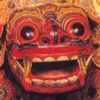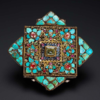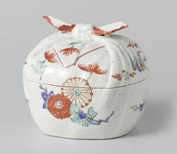MINORI EGASHIRA

The Meiji Period and its Objects
The Japanese Art Society of America’s ( JASA) 50th anniversary exhibition, “Meiji Modern: Fifty Years of New Japan” (2023–2024), reconsiders the art of the Meiji period (1868–1912), a tumultuous era defined by the collapse of the Tokugawa shogun government and the restoration of imperial rule. During this time, the Japanese leaders imported a dazzling array of newly available international philosophies and concepts, with the intent of swiftly industrialising the country. As a consequence, Meiji aesthetics are often thought of as heavily rooted in Euro-American artistic conventions. Indeed, many objects from the Meiji period employ forms familiar to viewers of Western art. However, these objects should not be judged merely by their exteriors. Meiji period artworks are complicated objects that incorporate a delicate balance of factors from both Japan and the world beyond.
Meiji art cannot be reduced to European-style art: an exemplary work from this period, that refutes accustomed narratives, is the brilliant Seal Case with Skeleton Procession Design (circa 1890) (1) by Nemoto (根本, active Meiji period). This inro (印籠, a small case typically worn with Japanese traditional attire, and suspended from a netsuke [根付] toggle) depicts a skeleton procession bearing a palanquin on one side and a party of cherry blossom revellers on the other. It cleverly incorporates gold lacquer, mother-of-pearl, tortoiseshell, ivory, coral and silver into its meticulous designs: the result of craftsmanship adapted from lacquering techniques developed in the Edo period (1603–1868) while also drawing on Ming dynasty (1368–1644) motifs. The object’s fine artistry invites the audience to imagine the delicate handcrafting process, which is impossible to be mass-produced even with modern technology. As Bradley M. Bailey, the Ting Tsung and Wei Fong Chao curator of Asian art at the Museum of Fine Arts, Houston (MFAH), explains, certain Meiji period artworks preferred to embrace minute details achievable only through the precise hand of the artist. Yet, some viewers deem Japanese art from this time as lacking originality. Why might that be so?

Nemoto’s Seal Case with Skeleton Procession Design embodies intricacy. At a glance, the viewer is invited to interact with the inro in an intimate manner. As the figures on the object are very small, they compel a closer look. An attentive observer might even begin to contemplate the materials employed in its design, which stand in for pigments and natural colourants for the images. From the milky white of ivory describing skeletal physiques to pink-tinted portions of mother-of-pearl portraying blooming cherry blossoms, each material holds both colour and the tale of its crafting. The story continues when the object is turned, as each side reveals an entirely different pictorial chronicle between the world of the dead and that of the living. As such, the viewer is enticed to flip the object in their hands to capture each narrative in its entirety.
The structure of the inro is also complex. It can be deconstructed into eight components, including the rope and the round, stone bead. Two of these pieces constitute its outer casing, preventing the entire object from falling apart. While presumably created to protect the small coffer, the frame is also covered in gold leaf and pictorial designs. The remaining four compartmental capsules comprise the main structure of the inro, allowing its owner to carry a variety of oddments within it. Accessing the hidden contents of the capsules first requires taking apart the external casing, as well as disassembling and reassembling the main coffer each time it is opened or closed.
The complicated form and function of the Seal Case with Skeleton Procession Design resulted from, and reflects, the aforesaid boisterous political and social climate of the Meiji period. The production of Meiji art was heavily impacted by the efforts of Japanese officials to align the nation with the social, political and cultural standards of the Euro-American powers, which had forced the country to open its ports to trade. The complicated and experimental nature of the inro makes it stand apart as an unique and eye-catching object. In the domain of art, the Western artistic categorisation system was transplanted over existing domestic aesthetic structures. This national change was an intentional move by the Japanese government, which hoped that Japan would demonstrate its rich historical traditions to the other global powers. However, as a result, much of the modernity of Meiji art is often overshadowed by a strong consciousness of the foreign. For instance, art critics and collectors of the day focused on what Japanese artists borrowed from other countries rather than their self-reflexive innovations. In terms of the inro, with its tiny, lifelike skeletons and luminous materiality, it is difficult to see at first glance that its origins also lie in old East Asian lacquer traditions.
Just as the case of the inro might suggest, Meiji period artworks are intricate objects that incorporate elements of different regions and periods. Moreover, they were also created to appeal to both international and domestic viewers. Here, the mixing of different styles from various countries could be read as proof of an art striving to transform and grow in tandem with changing times: in other words, of modernity. Further, this modernity is multidirectional. Artistic and political conversations between different countries led to the trading of diverse aesthetic traditions in the form of experimentation and the incorporation of various artistic styles.
The expression of the above perspectives is the primary goal of the exhibition, “Meiji Modern: Fifty Years of New Japan”, which presents works from the Meiji period as a distinct type of “modern”, with particular style and unique aspects that set the works apart from art anywhere else in the world. Travelling from the Asia Society Museum in New York (October 3rd, 2023 to January 7th, 2024), to the Smart Museum of Art in Chicago (March 21st, 2024 to June 9th, 2024), and the MFAH in Texas ( July 7th, 2024 to September 15th, 2024), this exhibition endeavours to reappraise the notion that the West had sole possession of the concept of modernity. By shifting focus from the overpublicised narrative of Meiji art as derivative, the present article encourages audiences to contemplate what Japanese modernity could truly mean by observing the techniques, materials, forms and content present in these Japanese masterpieces. This article also devotes special attention to the MFAH as the finale of this exquisite travelling exhibition.

Creating Modern Art Through Technique
Meiji art is notable for its abiding commitment to experimentation: representative works present a diverse range of techniques, both old and new, Japanese and foreign. This change is visible in colour woodblock prints, or nishiki-e (錦絵), which were popularised during the Edo period, but took on new directions in the late 19th century. In the Meiji period, artists, carvers, printers and publishers transformed the medium through experiments that minimised the thick black lines and simple colour touches of earlier works. The Meiji era woodblock print triptych, An Illustration of the Arrival of the Emperor at Shinbashi Station Following a Victory (1895) (2) by Kobayashi Kiyochika (小林清親, 1847–1915) is one such example. Initially, this print might look as if it breaks Japanese tradition for a more “Westernised” look. It depicts a scene of the Meiji emperor (alt. Mutsuhito [睦仁], 1852–1912) and his men in Western military attire being received by Japanese women wearing colourful Western dresses. Composed of softer pastel colours, that give the print a celebratory ambiance, the image loosely implements both one-point and atmospheric perspectives reminiscent of Western oil paintings or lithographs. For example, the supporting pillars of the train station are angled and square, shown in one-point perspective. Moreover, atmospheric perspective is displayed in the distant architectural structures of the print. Instead of a clear profile of the buildings, one perceives a smoky silhouette of the distant cityscape. The contour lines are made more delicate than in earlier woodblock prints, and colour variety has increased.
Yet, this print still holds onto distinctively Japanese artistic elements. The facial features of the figures are especially reminiscent of much earlier Japanese paintings and show little concern with mimesis, or the process of accurately portraying three-dimensional objects onto a two-dimensional surface. Furthermore, as a feature of the medium, most woodblock prints use outlines and muted colour palettes as intentional stylistic choices. As such, both European and domestic influences should be equally considered. Experimentation with European art conventions, being actively blended with older Japanese artistic traditions, created innovative pictures.
Another artwork that experiments with modern technical designs is the Vase with Hydrangea Design (circa 1900) (3) by Hayashi Kodenji (林小伝治, 1831–1915), in the collection of the MFAH. This cloisonné vessel consists of a rich, navy blue body with cream, periwinkle, and light peach hydrangea. The leaves, which peek between the bunches of flowers, alternate between light greens, dark greens and grey-blues. On initial impression, this vase is also reminiscent of woodblock prints. Outlines are employed throughout the vase, and the blending of a limited number of colours is implemented to create the various shades of hydrangea. The contrast between the light and airy flowers, the mid-toned leaves and the rich backdrop works in harmony to accentuate the entirety of the vase and add impactful contrasts. Keeping in mind the striking pictorial techniques, along with its size, it is no surprise to learn that similar objects were exhibited at international expositions. Expositions enabled a larger viewing space for artworks; the objects submitted needed to stand out in such vast venues. Thus, the Vase with Hydrangea Design’s choice of colour and size could have been impacted from the beginning by an intent to be shown at foreign expositions.
Here, too, the colouration and contours used in this vase are what make it global and modern. The artist uses a limited number of colours. However, by also incorporating different techniques, such as gradations of binary colours, the plant is made to look more three-dimensional and colourful despite the limitations. The gradations are made possible by the musen (無線) technique where the wiring is removed from the cloisonné before firing. Such methods became more popular and refined in the late Meiji period.
Referring to the aforementioned inro (1), the mixture of cultures becomes more apparent in its construction. As mentioned, the Edo period techniques used to create the object were previously used for lacquerware. While the lacquering techniques themselves had been readily used in East Asia since prehistoric times, the technique had become symbolic of wealth in Japan by the Edo period and was often utilised for larger pieces of furniture, such as those found in a bridal trousseau. Yet, the multi-cultured Shibayama lacquering technique, which implemented elaborate carving and the addition of various decorative materials onto the lacquered surfaces, only became popular during the Meiji period. Pointedly, the lacquerware industry was hit with new demands for different objects during the Meiji period. Due to economic pressures within Japan, many families stopped commissioning large, lacquered objects. In turn, smaller objects, such as inro, remained popular commodities.
In these ways, the Seal Case with Skeleton Procession Design and the Vase with Hydrangea Design are both traditional and innovative. They defy factory mass production by implementing hand-made skills, with a focus on detail and quality that may not initially be apparent. Simultaneously, they also answered to demands from both domestic and international consumers by adapting and mixing global designs. Meiji art is not one-dimensional. The experimentation and diverse techniques employed to create the works make them modern.

Creating Modern Art Through Material
The Wave Crest Supporting the Tide-Ruling Jewel (circa 1890) (4) by Yukihiro for the Kinshōdō studio (active Meiji period) is made of various materials, including a sizable rock crystal sphere and various metals, such as silver, bronze and gold. Although a mere 27.9 × 33.8 cm, no compromise has been made in its detail. The sphere is perfectly round, the visually stunning silver waves function to frame the overall object, and the bronze masses imitate true rocks in shape and texture. Gold and silver droplets animate the artwork and suggest the forceful splashing of waves. These scattered spheres direct the eye around the artwork and magnify the kinetic force the sculpture exudes.
Due to the European traditional emphasis on medium specificity, Wave Crest might appear unusual from a contemporary viewpoint due to its mixed medium. In fact, however, the materiality of the Wave Crest is steeped in the East Asian artistic tradition. Rather than stonework, it draws on Edo period traditions of sword making. Analogous to the forenamed inro (1) and the lacquer industry from which it sprang, many artisan families, who crafted swords and tsuba (鍔), or sword fittings, for samurai in the Edo period, faced a crisis in the Meiji period. Swords were abolished by the Meiji government during this time in accordance with the Sword Abolishment Edict of 1876, and thus all swords were abruptly expelled from the Japanese market. In order to survive, craftspeople were forced to shift their creative energies to making other forms of three-dimensional metalwork. Fortunately for these displaced artisans, their new craft quickly became popular in both Japanese and foreign markets. The remanence of tsuba-making techniques is visible in the Wave Crest Supporting the Tide-Ruling Jewel through the implementation of mixed metals. By creating new forms of work with older techniques, Meiji metalworkers created modern art with roots in indigenous crafts.

Comparably, the Censer in the Form of a Hawk (circa 1895) (5) by Aoki Tomonobu (active Meiji period) implements a technique with an unusual source. Aoki implements soft modelling, a traditional European technique, for the hawk, while also decorating the ends of the perch with the chrysanthemum seal of the emperor, a symbol which was “created and codified only after the Meiji Restoration”. As one can see through these sculptures, there are various ways in which art can become global. Each of these objects represents experimentation in metalwork during this time. Aoki’s sculpture, along with other remarkable metalworks, was recently acquired by the MFAH and will be on view in the exhibition.
Creating Modern Art Through Form
The concept of sculpture itself is a relatively young artistic notion in Japan. It was imported into the country in the Meiji period, along with the aforementioned European art philosophies. While carved three-dimensional objects existed in Japan long before that time, they were not considered sculptures in the same sense as in the West. However, they were readily sought after and accepted as Japanese art by the European market in the late 19th century, especially in the case of smaller sculptures. Why was this the case? Perhaps it was because they were, in a sense, a hint of the familiar in a foreign land. Many smaller Western statuettes were widely known from Classical Antiquity (Ancient Greece and Rome) and functioned in an analogous way. While their individual role was variable, classical statuettes seem to have been displayed in public spaces and personal homes for both votive and souvenir purposes. It is presumed that the familiar form, integrated with more “traditional Japanese” features, made these modern Japanese objects popular portable export art during the Meiji period.

This conflux of the recognisable and foreign served the purpose of familiarising Japanese art with its international rivals. For example, Japanese Buddhist icons were equated to personifications of gods and goddesses — internationally familiar as artistic subject matter at the time. Moreover, the cream colour of ivory, often used to create smaller Japanese carvings, paralleled the familiar marble used in ancient sculptures. Yet, this popularity came with unintended side effects. Simply, it equated “modernity” to “Westernisation”. This misconception eventually led to Meiji period artworks only being seen as imitative of art from the West, in which Japanese motifs were simply adapted to familiar Western forms. This view drastically undermines the initiative of Japanese artists, whose innovations and novel creations were otherwise flourishing during this period of drastic growth and experimentation. Naturally, this partial narrative, which has become the canon of Japanese sculptural history, needs to be amended. Meiji sculptures should also properly be seen as a product of the exploratory modern period from which they hail.
Here, the smaller Meiji period sculpture, Marishiten (摩利支天, deva Mārīcī, 1890) (6) by Doitsu (active Meiji period), is of interest. As a deva and bodhisattva of the sun and moon, her appearance varies depending on the particular depiction, although she is often distinguished by her three faces and association with a pig or a boar. Made of ivory, this carving accentuates minuscule details commonly featured in Meiji period sculpture. The method of carving implemented varies greatly depending on…
Click here to access Arts of Asia‘s Autumn 2023 issue for the full article.

 Subscribe
Subscribe Calendar
Calendar Links
Links Gift
Gift


